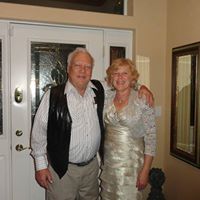Ronald Lee Sharp
age ~68
from Charlotte, NC
- Also known as:
-
- Ronald L Sharp
- Ronald Brown Sharp
- Ronald Lee Brown Sharp
- Ronald Lee Brownsharp
- Ronald Lee Brown-Sharp
- Ronald L Brown
- Ronald H
Ronald Sharp Phones & Addresses
- Charlotte, NC
- Baltimore, MD
- 3246 Plattmoor Dr, Myrtle Beach, SC 29588 • 9548510963
- Sunrise, FL
- Key West, FL
- Absecon, NJ
- 3246 Plattmoor Dr, Myrtle Beach, SC 29588 • 8432418180
Work
-
Company:Douglas w taylor
-
Address:6420 Normandy Dr, Charlotte, NC 28202
-
Phones:7043865681
-
Position:Partner
-
Industries:Junior Colleges and Technical Institutes
Education
-
Degree:Associate degree or higher
Resumes

Phys Ther
view sourceLocation:
Woodstock, MD
Industry:
Hospital & Health Care
Work:
Genesis Healthcare
Phys Ther
Phys Ther

Ronald Sharp
view source
Ronald Sharp
view source
Ronald Sharp
view source
Ronald Sharp
view source
Ronald Sharp
view sourceLawyers & Attorneys

Ronald Sharp - Lawyer
view sourceOffice:
Sharp & Ripley, PLLC
Specialties:
Government Law
Municipal Law
Eminent Domain
Commercial Law
Corporate Law
Municipal Law
Eminent Domain
Commercial Law
Corporate Law
ISLN:
903813639
Admitted:
1973
University:
University of Tennessee, B.S., 1970; Carson Newman College
Law School:
University of Tennessee, J.D., 1973

Ronald Sharp - Lawyer
view sourceOffice:
Ronald Farrington Sharp
Specialties:
Estate Planning
Probate
Real Estate
Power Of Attorney
Probate
Real Estate
Power Of Attorney
ISLN:
903813622
Admitted:
1975
University:
Western Michigan University, B.B.A.
Law School:
Wayne State University, J.D., 1975
License Records
Ronald G Sharp
License #:
RS050510A - Expired
Category:
Real Estate Commission
Type:
Real Estate Salesperson-Standard
Ronald R Sharp
License #:
RS101519A - Expired
Category:
Real Estate Commission
Type:
Real Estate Salesperson-Standard
Us Patents
-
Telecommunications System Using Directional Antennas
view source -
US Patent:53032403, Apr 12, 1994
-
Filed:Jul 8, 1991
-
Appl. No.:7/727031
-
Inventors:Jaime A. Borras - Hialeah FL
Thomas V. D'Amico - Boca Raton FL
Ronald E. Sharp - Plantation FL -
Assignee:Motorola, Inc. - Schaumburg IL
-
International Classification:G01S 372
-
US Classification:370 953
-
Abstract:A communication system 100 for determining the optimum direction (206) for transmitting and receiving a signal in a radio comprises a receiver for receiving a carrier signal being a time divided signal having an instruction signal, a transmitter for transmitting a time divided signal, a directional antenna (10) coupled to said receiver and transmitter, and a steering device (28) for changing the phase of the carrier signal in accordance with the instruction signal.
-
Burst Mode Receiver Control
view source -
US Patent:53254058, Jun 28, 1994
-
Filed:Aug 27, 1991
-
Appl. No.:7/750373
-
Inventors:Paul D. Marko - Ft. Lauderdale FL
David L. Brown - Miami FL
Jaime A. Borras - Hialeah FL
Ronald E. Sharp - Plantation FL -
Assignee:Motorola, Inc. - Schaumburg IL
-
International Classification:H04L 700
-
US Classification:375114
-
Abstract:A transceiver (100) is provided for transmitting during the transmission bursts (12) of a frame and receiving during the receiving time-slot windows (14). The transceiver (100) includes a receiver (320) for receiving a repeating radio frequency data (16) signal at any time within the receiving time-slot window (14) and for demodulating the repeating radio frequency data signal down to a baseband data signal. A data detector and clock recovery device (330) recovers the valid data (CHMP) from the baseband data signal. For controlling the receiver (320) and data detector and clock recovery device (330), a control circuit (400) modifies the receiving time-slot windows (14) to only receive and detect when valid data is expected (52).
-
Secure Over-The-Air Registration Of Cordless Telephones
view source -
US Patent:50777904, Dec 31, 1991
-
Filed:Dec 31, 1990
-
Appl. No.:7/635405
-
Inventors:Thomas V. D'Amico - Baco Raton FL
Ronald E. Sharp - Plantation FL -
Assignee:Motorola, Inc. - Schaumburg IL
-
International Classification:H04K 100
H04M 1100 -
US Classification:380 23
-
Abstract:A method for registration of a portable unit that may be utilized in a communication system that comprises a network controller, having a data base for storing portable identification numbers, a base station, and a portable unit, wherein a subscriber communicates to the network controller a first information set which comprises subscriber qualifying information, the portable identification number, and a key code that has been entered into the portable, and wherein the subscriber has entered a link identification number for over-the-air registration into a memory within the portable unit. The registration method comprises the following steps. The portable unit sends the base station a request for registration. The request for registration comprises the link identification number for over-the-air registration and the portable identification number. The base station receives the request for registration from the portable unit, and sends to the network controller a notice of the request for registration and the portable identification number.
-
Digital Programmable Tone Detector
view source -
US Patent:40216535, May 3, 1977
-
Filed:Oct 14, 1975
-
Appl. No.:5/621711
-
Inventors:Ronald Edward Sharp - Lauderhill FL
David Frank Willard - Plantation FL -
Assignee:Motorola, Inc. - Schaumburg IL
-
International Classification:G01R 2302
G01R 2314 -
US Classification:235152
-
Abstract:An improved detection arrangement for detecting the presence of a given tone in a received input signal. A reference generator, in the form of a reference clock and a programmable divider, produces a first reference frequency, equal to the frequency of the tone, and at an arbitrary phase angle thereto. A second generator output is in quadrature to the first. Each reference signal is product detected with the input signal via exclusive OR gates. A unique digital low pass filter, operating in a time multiplex mode, receives the gate outputs, removes all high frequency components therefrom, and produces pairs of output binary number encoded signals, each of which is representative of a vector component of a detected tone. Threshold detector circuitry monitors the outputs indicating an above threshold condition at its output in response to predetermined combinations of the binary numbers. The combinations represent all input vectors whose resultant absolute magnitude exceeds a chosen threshold.
-
Muting Of Radio-Transmitter Digital Audio Based On Received Signal Strength
view source -
US Patent:54086930, Apr 18, 1995
-
Filed:Dec 24, 1991
-
Appl. No.:7/812994
-
Inventors:Kenneth D. Alton - Coral Springs FL
Ronald E. Sharp - Plantation FL
Mark S. Stuglik - Margate FL
David L. Brown - Miami FL -
Assignee:Motorola, Inc. - Schaumburg IL
-
International Classification:H04B 116
-
US Classification:455212
-
Abstract:A radio communication device (10) comprises a radio transceiver (12), having a received signal strength indicator (RSSI) (16), an audio section (22), and a controller (16) for deactivating the audio section whenever the RSSI indicates the the received signal strength is below a predetermined threshold. The controller also operates as a counter (26) for indicating the length of time that the received signal strength has been below the predetermined threshold.
-
Burst Mode Receiver Control
view source -
US Patent:54024480, Mar 28, 1995
-
Filed:Feb 10, 1994
-
Appl. No.:8/194760
-
Inventors:Paul D. Marko - Ft. Lauderdale FL
David L. Brown - Miami FL
Jaime A. Borras - Hialeah FL
Ronald E. Sharp - Plantation FL -
Assignee:Motorola Inc. - Schaumburg IL
-
International Classification:H03D 100
-
US Classification:375340
-
Abstract:A transceiver (100) is provided for transmitting during the transmission bursts (12) of a frame and receiving during the receiving time-slot windows (14). The transceiver (100) includes a receiver (320) for receiving a repeating radio frequency data (16) signal at any time within the receiving time-slot window (14) and for demodulating the repeating radio frequency data signal down to a baseband data signal. A data detector and clock recovery device (330) recovers the valid data (CHMP) from the baseband data signal. For controlling the receiver (320) and data detector and clock recovery device (330), a control circuit (400) modifies the receiving time-slot windows (14) to only receive and detect when valid data is expected (52).
-
Stanby Mode Controller Utilizing Microprocessor
view source -
US Patent:43815529, Apr 26, 1983
-
Filed:Nov 18, 1980
-
Appl. No.:6/208101
-
Inventors:Ronald E. Sharp - Sunrise FL
Emilio J. Cuadra - Miami FL -
Assignee:Motorola Inc. - Schaumburg IL
-
International Classification:G06F 1300
G06F 100
G11C 700 -
US Classification:364900
-
Abstract:Logic circuitry in a portable electronic device is combined with the microprocessor to reduce power consumption in the microprocessor and its associated memories during inactive periods of the device, with periodic sampling for inputs from peripherals or received data which would require active operation of the device.
-
Method And Apparatus For Providing Power Conservation In A Communication System
view source -
US Patent:52652700, Nov 23, 1993
-
Filed:Jun 3, 1991
-
Appl. No.:7/709044
-
Inventors:Robert E. Stengel - Ft. Lauderdale FL
Ronald E. Sharp - Plantation FL
Francis R. Yester - Arlington Heights IL -
Assignee:Motorola, Inc. - Schaumburg IL
-
International Classification:H04B 116
-
US Classification:455343
-
Abstract:A communication device 200 capable of operating in a communication system 100 having a control system which generates information signals with redundant information is disclosed. The communication device comprises: a receiver 214 for receiving the information signals; a circuit which can determine the signal quality of the received information signals 234; and a controller 226 which decodes the received information signals, and further compares the signal quality of the information signals with a predetermined value, and decides if the received signal quality is at least equal to the predetermined value in order to only decode a portion of the information signal. Upon the communication device decoding a portion of the information signal, the communication device 200 is placed in a battery saving mode in order to conserve battery life.
Isbn (Books And Publications)







Name / Title
Company / Classification
Phones & Addresses
Partner
Douglas W Taylor
Junior Colleges and Technical Institutes
Junior Colleges and Technical Institutes
6420 Normandy Dr, Charlotte, NC 28202
RON SHARP ENTERPRISES
SHARP EDGE PAINTING LLC
President, Director
Arthur R. Lanni Memorial Post 365, The American Legion, Department of Florida, Inc
10101 Sunrise Lk Blvd, Fort Lauderdale, FL 33322
7115 6561 Sunset Strip, Fort Lauderdale, FL 33313
7115 6561 Sunset Strip, Fort Lauderdale, FL 33313
R&G OUTERLIMITS LLC
MIRACLES OF FAITH MINISTRIES
Director
Fort Lauderdale Professional Sports, Inc
2166 Nova Vlg Dr, Fort Lauderdale, FL 33317
President, Director
Sharp Cellular Corp
1251 NW 78 Ter, Fort Lauderdale, FL 33322
Wikipedia

Rald Sharp
view sourceRonald William Sharp (b.1929) is an organ builder based in Sydney, Australia. He specialised in mechanical, tracker action instruments, and was responsible ...
Googleplus

Ronald Sharp

Ronald Sharp

Ronald Sharp
Classmates

Ronald Sharp
view sourceSchools:
Garfield Junior High School Johnstown PA 1955-1959
Community:
Roger Mcclelland, Rino Passaniti, Robert Pribish

Ronald Sharp Sr (Sharp)
view sourceSchools:
Aquin Central Catholic High School Freeport IL 1953-1957
Community:
Mary Linzmaier

Ronald Sharp
view sourceSchools:
Blessed Sacrament School Midland MI 1955-1961

Ronald Sharp
view sourceSchools:
Tolleston High School Gary IN 1947-1951
Community:
Anita Sakes, Jacqueline Magee, Lionel Rockey, Ezzard Donahue, Reginald Marcus

Ronald Sharp
view sourceSchools:
Silver Springs Elementary School Silver Springs NV 1994-1998, Silver Stage High School Silver Springs NV 2002-2006
Community:
Ashley Tinsley

Ronald Sharp
view sourceSchools:
Jacksboro High School Jacksboro TN 1963-1967
Community:
Betty Pounders, Sandy Lafever

Ronald Sharp
view sourceSchools:
Leavittsburg High School Leavittsburg OH 1952-1956
Community:
Raymond Hays, Duanne Decker, Pam Joyce, Allen Briggs, Ruth Hill

Ronald Sharp Sr (Sharp)
view sourceSchools:
Tampico High School Tampico IL 1953-1957
Community:
Gene Beatty, Debbie Bruns, Ronald Hesser, Bob Frazier, Tina Edeus, Mark Duran

Ronald J Sharp Jr.
view source
Ronald Sharp
view source
Ronald Sharp
view source
Ronald Sharp
view source
Ronald Farrington Sharp
view source
Ronald D Sharp
view source
Ronald C Sharp
view source
Ronald Earl Sharp
view sourceFlickr
Youtube
Get Report for Ronald Lee Sharp from Charlotte, NC, age ~68













